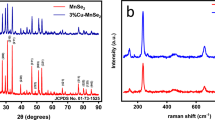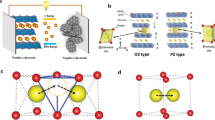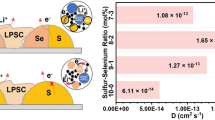Abstract
This study explores the capabilities of solvothermally synthesized bismuth telluride (Bi2Te3) hexagonal platelets as a promising anode material for both Li-ion and Na-ion batteries. Bi2Te3 anode material exhibits a high initial discharge capacity of 837 mA h g−1 at a current density of 100 mA g−1 against Li metal whereas, an initial discharge capacity of 678 mA h g−1 is observed at a current density of 20 mA g−1 for the same against the Na metal. The Li- and Na-storage mechanism in Bi2Te3 platelets has been investigated by using both galvanostatic charge–discharge and cyclic voltammetry measurements. X-ray diffraction, scanning electron microscopy, transmission electron microscopy, and Raman spectroscopy techniques have been used to examine the structural characteristics, surface morphology, and lattice vibrational modes of Bi2Te3 hexagonal platelets. Further, FTIR spectroscopy was employed to determine the presence of functional groups while X-ray photoelectron spectroscopy was employed for the elemental analysis of Bi2Te3 sample.
Graphical abstract












Similar content being viewed by others
Data availability
Data generated and analyzed during the study will be made available from the corresponding author upon reasonable request.
References
Bin CC, Tsai CY, Chen KT, Tuan HY (2021) Solution-grown phosphorus-hyperdoped silicon nanowires/carbon nanotube bilayer fabric as a high-performance lithium-ion battery anode. ACS Appl Energy Mater 4:3160–3168. https://doi.org/10.1021/acsaem.0c02932
Geng H, Zhou Q, Zheng J, Gu H (2014) Preparation of porous and hollow Fe3O4@C spheres as an efficient anode material for a high-performance Li-ion battery. RSC Adv 4:6430–6434. https://doi.org/10.1039/c3ra45300f
O’Heir J (2017) Building better batteries. Mech Eng 139(1):10–11
Fang C, Huang Y, Zhang W et al (2016) Routes to high energy cathodes of sodium-ion batteries. Adv Energy 6(5):1501727. https://doi.org/10.1002/aenm.201501727
Du Y, Zhang B, Zhang W et al (2021) Interfacial engineering of Bi2Te3/Sb2Te3 heterojunction enables high–energy cathode for aluminum batteries. Energy Storage Mater 38:231–240. https://doi.org/10.1016/j.ensm.2021.03.012
Xu J, Ma J, Fan Q et al (2017) Recent progress in the design of advanced cathode materials and battery models for high-performance lithium-X (X = O2, S, Se, Te, I2, Br2) batteries. Adv Mater 29(28):1606454. https://doi.org/10.1002/adma.201606454
Shi L, Zhao T (2017) Recent advances in inorganic 2D materials and their applications in lithium and sodium batteries. J Mater Chem A Mater 5:3735–3758. https://doi.org/10.1039/c6ta09831b
Zhang C, Wang A, Zhang J et al (2018) 2D materials for lithium/sodium metal anodes. Adv Energy 8(34):1802833. https://doi.org/10.1002/aenm.201802833
Liu J, Bao Z, Cui Y et al (2019) Pathways for practical high-energy long-cycling lithium metal batteries. Nat Energy 4:180–186. https://doi.org/10.1038/s41560-019-0338-x
Khatua S, Rao YB, Achary KR, Patro LN (2023) Li-ion transport studies of NASICON-type LiZr2(PO4)3 solid electrolyte crystallizing in rhombohedral structure at room temperature. Surf Interfaces 41:103212. https://doi.org/10.1016/j.surfin.2023.103212
Hwang JY, Myung ST, Sun YK (2017) Sodium-ion batteries: present and future. Chem Soc Rev 46:3529–3614. https://doi.org/10.1039/c6cs00776g
Slater MD, Kim D, Lee E, Johnson CS (2013) Sodium-ion batteries. Adv Funct Mater 23:947–958. https://doi.org/10.1002/adfm.201200691
Bhaskara Rao Y, Achary KR, Patro LN (2022) Enhanced electrochemical performance of the Na3V2(PO4)3/C cathode material upon doping with Mn/Fe for Na-ion batteries. ACS Omega 7:48192–48201. https://doi.org/10.1021/acsomega.2c06261
Li Z, Zhong W, Cheng D, Zhang H (2021) One-step large-scale fabrication of Bi@N-doped carbon for ultrahigh-rate and long-life sodium-ion battery anodes. J Mater Sci 56:11000–11010. https://doi.org/10.1007/s10853-021-05978-z
Xiao B, Rojo T, Li X (2019) Hard carbon as sodium-ion battery anodes: progress and challenges. Chemsuschem 12:133–144. https://doi.org/10.1002/cssc.201801879
Mao J, Zhou T, Zheng Y et al (2018) Two-dimensional nanostructures for sodium-ion battery anodes. J Mater Chem A Mater 6:3284–3303. https://doi.org/10.1039/c7ta10500b
Wang N, Chu C, Xu X et al (2018) Comprehensive new insights and perspectives into Ti-based anodes for next-generation alkaline metal (Na+, K+) ion batteries. Adv Energy Mater 8(27):1801888. https://doi.org/10.1002/aenm.201801888
Yang J, Zhou X, Wu D et al (2016) S-doped N-rich carbon nanosheets with expanded interlayer distance as anode materials for sodium-ion batteries. Adv Mater. 29(6):1–5. https://doi.org/10.1002/adma.201604108
Li W, An C, Guo H et al (2019) In situ synthesis of 1D mesoporous MnO@C nanorods for high performance Li-ion batteries. ACS Sustain Chem Eng 7:139–146. https://doi.org/10.1021/acssuschemeng.8b01782
Weiya Q, Zhu H, Yu Jin S et al (2023) High-performance lithium-ion batteries with different hollow-degree Fe3O4@C hollow nanostructures. Appl Surf Sci 608:155093. https://doi.org/10.1016/j.apsusc.2022.155093
Pang S, Hu Z, Fan C et al (2022) Insights into the sodium storage mechanism of Bi2Te3nanosheets as superior anodes for sodium-ion batteries. Nanoscale 14:1755–1766. https://doi.org/10.1039/d1nr07960c
Sha M, Zhang H, Nie Y et al (2017) Sn nanoparticles@nitrogen-doped carbon nanofiber composites as high-performance anodes for sodium-ion batteries. J Mater Chem A 5:6277–6283. https://doi.org/10.1039/C7TA00690J
Orzech MW, Mazzali F, McGettrick JD et al (2017) Synergic effect of Bi, Sb and Te for the increased stability of bulk alloying anodes for sodium-ion batteries. J Mater Chem A 5:23198–23208. https://doi.org/10.1039/c7ta07648g
Park CM, Yoon S, Il LS, Sohn HJ (2009) Enhanced electrochemical properties of nanostructured bismuth-based composites for rechargeable lithium batteries. J Power Sources 186:206–210. https://doi.org/10.1016/j.jpowsour.2008.09.097
Yang F, Yu F, Zhang Z et al (2016) Bismuth nanoparticles embedded in carbon spheres as anode materials for sodium/lithium-ion batteries. Chem Eur J 22:2333–2338. https://doi.org/10.1002/chem.201503272
Yin H, Li Q, Cao M et al (2017) Nanosized-bismuth-embedded 1D carbon nanofibers as high-performance anodes for lithium-ion and sodium-ion batteries. Nano Res 10:2156–2167. https://doi.org/10.1007/s12274-016-1408-z
Zuo W, Zhu W, Zhao D et al (2016) Bismuth oxide: a versatile high-capacity electrode material for rechargeable aqueous metal-ion batteries. Energy Environ Sci 9:2881–2891. https://doi.org/10.1039/c6ee01871h
Yuan Y, Hu T, Zhong X et al (2020) Highly sensitive photoelectrochemical biosensor based on quantum dots sensitizing Bi2Te3 nanosheets and DNA amplifying strategies. ACS Appl Mater Interfaces 12(20):22624–22629. https://doi.org/10.1021/acsami.0c04536
Wang M, Fu Q, Yan L et al (2019) Energy, Environmental, and Catalysis Applications Bi2Te3 topological insulator as a new and outstanding counter electrode material for high-efficiency and endurable flexible perovskite solar cells. ACS Appl Mater Interfaces 11(51):47868–47877. https://doi.org/10.1021/acsami.9b15320
Uddin I, Abzal SM, Kalyan K et al (2022) Starch-assisted synthesis of bi2s3 nanoparticles for enhanced dielectric and antibacterial applications. ACS Omega 7:42438–42445. https://doi.org/10.1021/acsomega.2c05593
Wen S, Zhao J, Zhu Y et al (2020) Carbon-encapsulated Bi2Te3 derived from metal-organic framework as anode for highly durable lithium and sodium storage. J Alloys Compd 837:155536. https://doi.org/10.1016/j.jallcom.2020.155536
Liu X, Si Y, Li K et al (2021) Exploring sodium storage mechanism of topological insulator Bi2Te3 nanosheets encapsulated in conductive polymer. Energy Storage Mater 41:255–263. https://doi.org/10.1016/j.ensm.2021.06.004
Liu M, Yin S, Ren T et al (2021) Two-dimensional heterojunction electrocatalyst: Au-Bi2Te3 nanosheets for electrochemical ammonia synthesis. ACS Appl Mater Interfaces 13:47458–47464. https://doi.org/10.1021/acsami.1c11246
Teweldebrhan D, Goyal V, Balandin AA (2010) Exfoliation and characterization of bismuth telluride atomic quintuples and quasi-two-dimensional crystals. Nano Lett 10:1209–1218. https://doi.org/10.1021/nl903590b
Masood KB, Jain N, Singh J (2020) Electrochemical performance of Bi2Te3/GO composite anode for LIB application. Int J Appl Ceram Technol 17:1422–1429. https://doi.org/10.1111/ijac.13445
Gayner C, Menezes LT, Natanzon Y et al (2023) Development of nanostructured Bi2Te3 with high thermoelectric performance by scalable synthesis and microstructure manipulations. ACS Appl Mater Interfaces 15:13012–13024. https://doi.org/10.1021/acsami.2c21561
Chiba T, Yabuki H, Takashiri M (2023) High thermoelectric performance of flexible nanocomposite films based on Bi2Te3 nanoplates and carbon nanotubes selected using ultracentrifugation. Sci Rep 13(1):3010. https://doi.org/10.1038/s41598-023-30175-0
Zhang Z, Sun M, Liu J et al (2022) Ultra-fast fabrication of Bi2Te3 based thermoelectric materials by flash-sintering at room temperature combining with spark plasma sintering. Sci Rep 12:10045. https://doi.org/10.1038/s41598-022-14405-5
Ashfaq A, Sabugaa MM, Ben MM et al (2023) High thermoelectric power factor of Sr doped Bi2Te3 thin film through energy filtering effect. Int Commun Heat Mass Transf 143:106719. https://doi.org/10.1016/j.icheatmasstransfer.2023.106719
Brunauer S, Emmett PH, Bergmann E, Weizmann A (1935) Communications to the editor. J Am Chem Soc 57:1754–1756. https://doi.org/10.1021/ja01312a077
Mamur H, Dilmac OF, Korucu H, Bhuiyan MRA (2018) Cost-effective chemical solution synthesis of bismuth telluride nanostructure for thermoelectric applications. Micro Nano Lett 13:1117–1120. https://doi.org/10.1049/mnl.2018.0116
Wu Z, Mu E, Wang Z et al (2019) Bi2Te3 nanoplates’ selective growth morphology on different interfaces for enhancing thermoelectric properties. Cryst Growth Des 19(7):3639–3646. https://doi.org/10.1021/acs.cgd.8b01632
Majji M, Abzal SM, Jacob N et al (2024) Efficient photocatalytic green hydrogen production using crystalline elemental Boron nanostructures under visible light. Int J Hydrog Energy 56:338–347. https://doi.org/10.1016/j.ijhydene.2023.12.113
Yu L, Tian P, Tang L et al (2023) Extended wavelength and enhanced sensitivity of PbS colloidal quantum dots/Bi2Te3 photodetector by band alignment engineering. Mater Des 229:111934. https://doi.org/10.1016/j.matdes.2023.111934
Ahmad M, Agarwal K, Mehta BR (2020) An anomalously high Seebeck coefficient and power factor in ultrathin Bi2Te3film: spin-orbit interaction. J Appl Phys 128:035108. https://doi.org/10.1063/5.0007440
Tarachand SM, Okram GS et al (2021) Enhanced thermoelectric performance of solution-grown Bi2Te3 nanorods. Mater Today Energy 21:100700. https://doi.org/10.1016/j.mtener.2021.100700
Raju JM, Thomas KJ (2023) Topological insulator phases in polycrystalline Bi2Te3thin films. AIP Adv 13:025045. https://doi.org/10.1063/5.0136626
Nour A, Hamida RS, El-Dissouky A et al (2023) One-pot facile synthesis of hexagonal Bi2Te3 nanosheets and its novel nanocomposites: characterization, anticancer, antibacterial, and antioxidant activities. Colloids Surf B Biointerfaces 225:113230. https://doi.org/10.1016/j.colsurfb.2023.113230
Palanisamy G, Bhuvaneswari K, Bharathi G et al (2021) Improved photocatalytic performance of magnetically recoverable Bi2Te3/CdS/CuFe2O4 nanocomposite for MB dye under visible light exposure. Solid State Sci 115:106584. https://doi.org/10.1016/j.solidstatesciences.2021.106584
Lee M, Fardis M, Papavassiliou G, Dcef DOI (2020) CrystEngComm 22(45):7918–7928. https://doi.org/10.1039/D0CE00719F
Mahvi M, Delavari HH, Poursalehi R (2018) Rapid microwave-assisted synthesis of Bi2Te3 nanoflakes as an efficient contrast agent for X-ray computed tomography. Ceram Int 44:9679–9683. https://doi.org/10.1016/j.ceramint.2018.02.196
Long B, Qiao Z, Zhang J et al (2019) Polypyrrole-encapsulated amorphous Bi2S3 hollow sphere for long life sodium ion batteries and lithium–sulfur batteries. J Mater Chem A Mater 7:11370–11378. https://doi.org/10.1039/C9TA01358J
Ghosh A, Shukla S, Monisha M et al (2017) Sulfur co-polymer a new cathode structure for room temperature sodium-sulfur batteries. ACS Energy Lett 2(10):2478–2485. https://doi.org/10.1021/acsenergylett.7b00714
Lu C, Luo M, Dong W et al (2023) Bi2Te3/Bi2Se3/Bi2S3 cascade heterostructure for fast-response and high-photoresponsivity photodetector and high-efficiency water splitting with a small bias voltage. Adv Sci 10:2205460. https://doi.org/10.1002/advs.202205460
Wang Q, Wang S, Wei N et al (2022) Aqueous zinc-ion batteries based on a 2D layered Bi2Te3 cathode. Chem Eng J 450:138132. https://doi.org/10.1016/j.cej.2022.138132
Nan J, Liu Y, Chao D et al (2023) Crystal defect engineering of Bi2Te3 nanosheets by Ce doping for efficient electrocatalytic nitrogen reduction. Nano Res 16:6544–6551. https://doi.org/10.1007/s12274-022-5319-x
Cunningham PT, Johnson SA, Cairns EJ (1973) Phase equilibria in lithium-chalcogen systems: III lithium-tellurium. J Electrochem Soc 120(3):328–330. https://doi.org/10.1149/1.2403448
Tu F, Xie J, Cao G, Zhao X (2012) Self-Assembly of Bi2Te3-nanoplate/graphene-nanosheet hybrid by one-pot route and its improved Li-storage properties. Materials 5:1275–1284. https://doi.org/10.3390/ma5071275
Gillard CHR, Jana PP, Rawal A, Sharma N (2021) Electrochemical phase evolution of tetradymite-type Bi2Te3 in lithium, sodium and potassium ion half cells. J Alloys Compd 854:155621. https://doi.org/10.1016/j.jallcom.2020.155621
Sahu SR, Parimala Devi D, Phanikumar VVN et al (2018) Tamarind seed skin-derived fiber-like carbon nanostructures as novel anode material for lithium-ion battery. Ionics 24:3413–3421. https://doi.org/10.1007/s11581-018-2498-2
Cui J, Zheng H, Zhang Z et al (2021) Origin of anomalous high-rate Na-ion electrochemistry in layered bismuth telluride anodes. Matter 4:1335–1351. https://doi.org/10.1016/j.matt.2021.01.005
Li D, Zhou J, Chen X, Song H (2018) Graphene-loaded Bi2Se3: a conversion–alloying-type anode material for ultrafast gravimetric and volumetric Na storage. ACS Appl Mater Interfaces 10:30379–30387. https://doi.org/10.1021/acsami.8b09538
Sun D, Zhang G, Li D et al (2019) A layered Bi2Te3 nanoplates/graphene composite with high gravimetric and volumetric performance for Na-ion storage. Sustain Energy Fuels 3:3163–3171. https://doi.org/10.1039/C9SE00544G
Acknowledgements
JKD acknowledges the partial financial support from UGC-DAE CSR through a Collaborative Research Scheme (CRS) (project number: CRS/2022-23/1092) and L.N. Patro acknowledges the support from university research grant (SRMAP/URG/E&PP/2022-23/001). The authors thank SRM-IST SCIF and NRC facilities for elemental and microscopy analysis.
Author information
Authors and Affiliations
Contributions
JKD, LNP, and RP conceived and designed the study. SMA synthesized the materials and YBR, SK, PM, and SMA performed the measurements. JKD, SMA, SLJ, and KK wrote the first draft of the manuscript, which was reviewed by LNP, RP, and JKD. All authors read and approved the final manuscript.
Corresponding authors
Ethics declarations
Conflict of interest
The authors declare that they have no known competing financial interests or personal relationships that could have appeared to influence the work reported in this work. The following Supporting Information is available and includes the crystal growth process of Bi2Te3, the X-ray diffraction pattern of precursor materials, crystallite sizes, etc.
Additional information
Handling Editor: Jean-Francois Gohy.
Publisher's Note
Springer Nature remains neutral with regard to jurisdictional claims in published maps and institutional affiliations.
Supplementary Information
Below is the link to the electronic supplementary material.
Rights and permissions
Springer Nature or its licensor (e.g. a society or other partner) holds exclusive rights to this article under a publishing agreement with the author(s) or other rightsholder(s); author self-archiving of the accepted manuscript version of this article is solely governed by the terms of such publishing agreement and applicable law.
About this article
Cite this article
Abzal, S.M., Janga, S.L., Bhaskara Rao, Y. et al. Solvothermally synthesized bismuth telluride hexagonal platelets as an efficient anode material for lithium- and sodium-ion batteries. J Mater Sci 59, 6879–6893 (2024). https://doi.org/10.1007/s10853-024-09571-y
Received:
Accepted:
Published:
Issue Date:
DOI: https://doi.org/10.1007/s10853-024-09571-y




